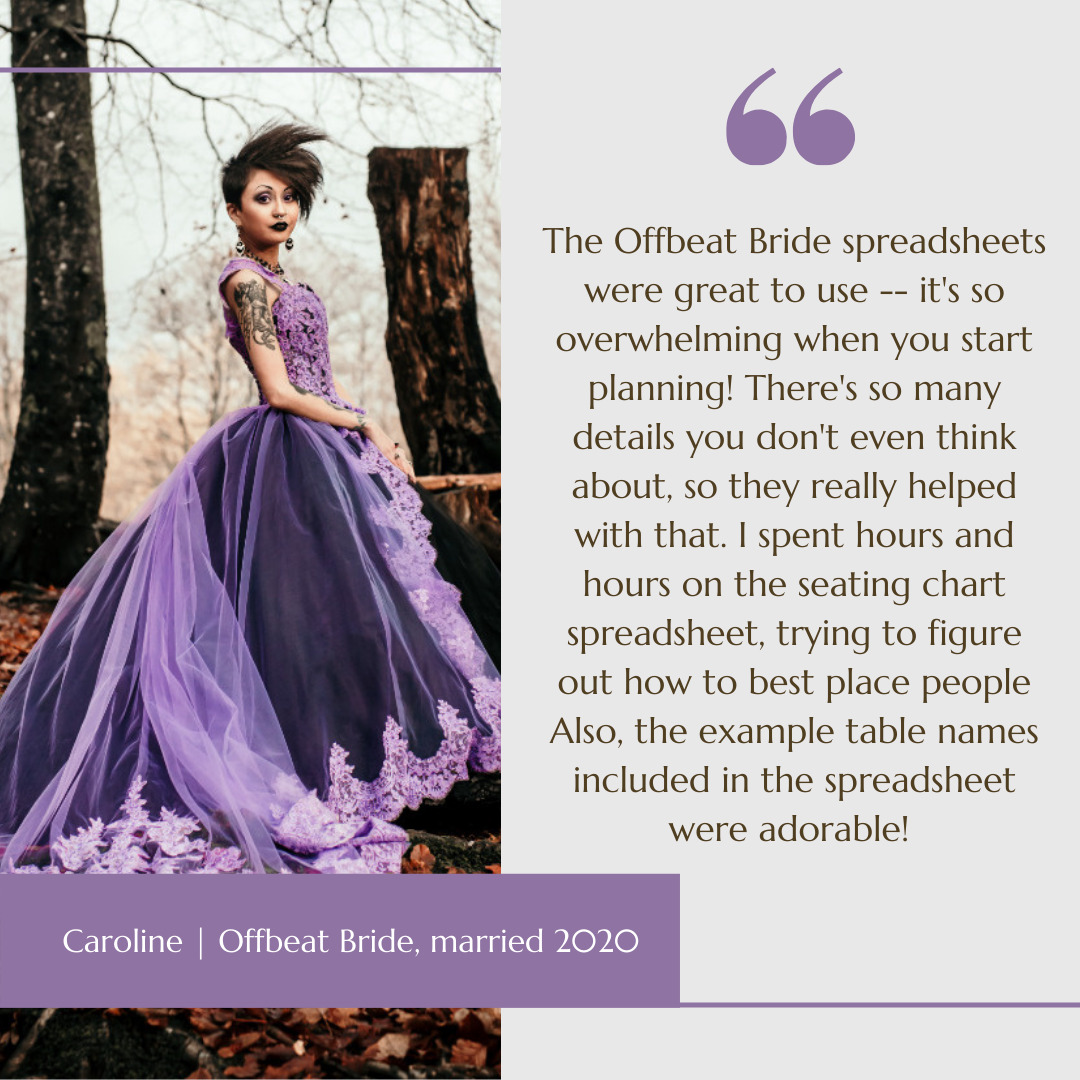
Creating a wedding day timeline is a great way to make sure your event runs smoothly. Sometimes, however, weddings have a mind of their own and don't particularly enjoy being held to a precise schedule. Below are a few tips and tricks to help create a realistic timeline that leads to less worry and more party.
First, who is a wedding day timeline actually for?
Let's get this clear first: A wedding day schedule or timeline is really designed for the wedding vendors, not the guests. If you’ve hired a professional photographer or DJ, they are very likely to touch base with you prior to the wedding to cover these types of timing questions so that on the wedding day they can be in position with music cued and batteries charged, ready to go when you are.
As a wedding coordinator, it’s part of my job to communicate key timing to the vendors. But if the timeline says it’s time for cake cutting at a moment when you’re bustin’ a move on the dance floor, then we hold off a bit. Again, nothing is set in stone. A wedding day timeline just helps whoever is coordinating and/or the key vendors if they have an idea of what to expect.
So for those with a large time gap in between the ceremony and reception, or for those with a super laid-back party – you could just note whatever timing is applicable to you.
A good rule of thumb is: If a wedding vendor needs to start something, end something, serve something, play something, or photograph something – noting the general timing you have in mind simply helps them do it.
Basic wedding timeline overview
Let's start with the basics for your wedding plans. As a wedding planner, I've learned that the vast majority of North American weddings tend to have a natural six-hour arc that goes something like this:
 Is four hours long enough for a reception?
Is four hours long enough for a reception?
"The venue we're looking at allows us to be there for four hours. Is this long enough for a reception?" For the answer to this,... Read more
- 3:00 First look and other scheduled photos
- 4:00 Ceremony starts
- 4:30 – 5:30 Cocktail Hour
- 5:30 – 7:00 Dinner
- 7:00 – 10:00 Party
I'm always a bit amazed that no matter how unique your wedding venue is, or how fantastic of a band/DJ/fire juggler you've booked, the natural end always seems to come right at about that six-hour mark. Therefore, I base my timelines accordingly, knowing that I can always build in a little wiggle room one way or the other for special circumstances.
Once you have the nuts and bolts of your timing in place, you'll want to fill in the special details which I call “bells and whistles.” In the realm of offbeat weddings, these details can be absolutely anything. (“The electric jellyfish enter when, exactly?” is one of the more famous questions I've asked when building a timeline.)
However, for the purposes of this discussion and in an effort to keep it simple, I'm going to use traditional items here such as: grand entrance, toasts, first dance, etc. Generally, anything that would be considered a special moment (like a first look, sunset photos or other “I sure hope my photographer gets a shot of this!” moments) should be noted on the timeline.
When it comes to the timing of photographing wedding day preparing (stuff like the bride putting on makeup, family photos, wedding party shots, bridesmaids preparing, groomsmen goofing off, extended family portraits, etc) talk to your photographer. They likely have their own wedding day timeline for photographs, and it's great to work with them.
Some of these items have clear points where they would likely happen, such as making your grand entrance at the very beginning of the reception. Others have multiple options where you might need to give a little thought to when you would like to do certain things.
A few suggestions:
First Dance: Either just after the grand entrance, or immediately after dinner to kick off dancing.
Toasts: Often placed just prior to the start of dinner, which is fine if there are two, maybe three speeches. But for more than a few toasters (ha, I said toasters!) you may want to consider moving some (or all) of them towards the end of the meal. Guests will be better engaged during the toasts if they have full bellies.
Cake Cutting: Personally, I like to hold cake cutting until about 45 minutes or so after dinner, especially if you paid good money for some gorgeous confection. Enjoy the display a bit longer! However, it's not a crime to cut and serve your cake right on the heels of dinner if you prefer to have dessert right away.
After you take your bells and whistles and plug them into your timeline, it'll start to look something like this:
Wedding day timeline template
- 4:00 Ceremony start time
- 4:30 – 5:30 Cocktail Hour
- 5:30 Grand Entrance to First Dance
- 5:45 Toasts
These could be from best man, maid of honor, father of the groom, or other folks - 6:00 – 7:30 Dinner
- 7:30 First Dance, followed by Father/Daughter Dance
- 7:45 Open Dancing begins – make sure you plan your parent dances
- 8:30 Cake Cutting
- 9:30 Bouquet Toss / Garter toss
- 9:55 Last Song
Make sure folks know this is their last chance to get on the dance floor - 10:00 End – make your grand exit and drive off in your getaway car!
This is the type of timeline vendors such as photographers, videographers, DJs, and caterers want to see. Concise and clean with the specific key points of the wedding reception clearly noted. You may also find it helpful to create a second, more detailed timeline for the person coordinating your event. This would include vendor arrival times as well as what time the couple, the bridal party and VIP family members are expected on site, along with some notes about your specific set up instructions.
For extra credit, add columns to your timeline, that include names of those responsible for action items, with their contact info. Then you hand out the timeline to all bridal party members, your parents, your planner or coordinator if you have one (we will have day-of coordination help only), as well as all vendors.
If anyone is MIA, your VIP’s have their number(s) and it’s not your problem. That way, vendors and anyone helping know things like when the bar staff takes their meal break, when the bouquet toss needs to be organized, etc, and can help support things staying on track.
Ready for the secret ingredient of timelines?
Two words: Buffer. Time. The key to running a smooth event is building pockets of buffer time discreetly into the timeline.
If you look at the example above, there are several areas where I snuck in those little pockets. Most of my clients' wedding ceremonies are only 15-20 minutes long, but I always include 30 minutes for ceremony so that a start time delay doesn't impact the rest of the reception. (And if you're on time, you'll just have a little extra cocktail hour time which is not a terrible thing.) The grand entrance to first dance will probably take five minutes total, but I rounded up.
Always. Round. Up. It's very easy to bump up the timing of an event (and just have more time to party in the end), but it's really difficult to stop a spectacular domino effect once it's begun.
My final tip:
Remember, your wedding timeline is a guideline and nothing is set in stone. Short of making sure your food gets served while it's hot and fresh, it's always best to follow the timeline as feels appropriate in the moment. A little flexibility goes a long way and is ultimately the key to enjoying a wedding day that feels natural, comfortable and just plain fun.
Want more help getting your wedding day organized?
If you want to REALLY get your day organized, be sure to download our spreadsheets. They help you get your stuff ORGANIZED. You can download them here:
DOWNLOAD THE SPREADSHEETS

DOWNLOAD THE SPREADSHEETS





